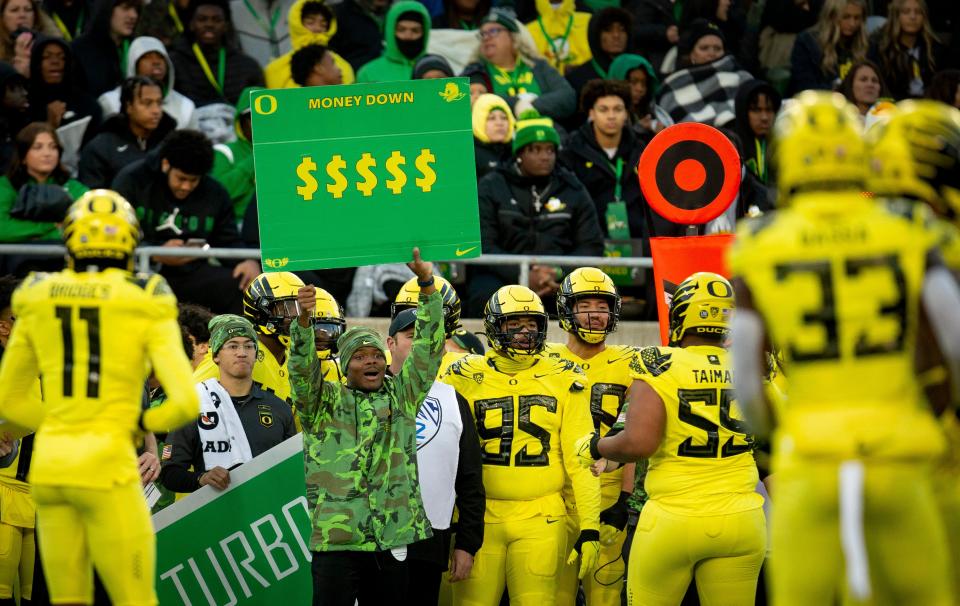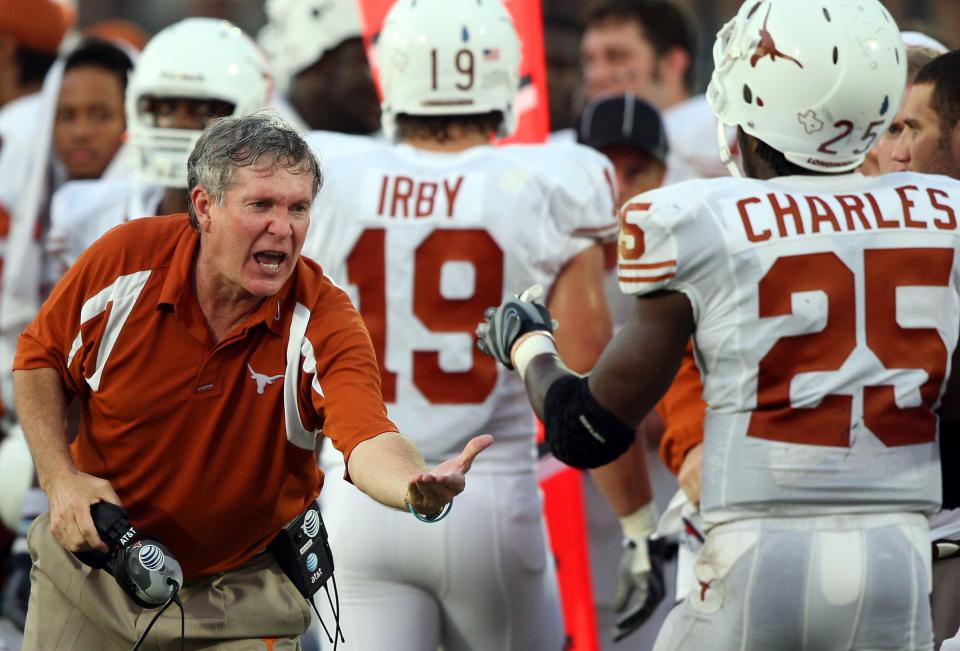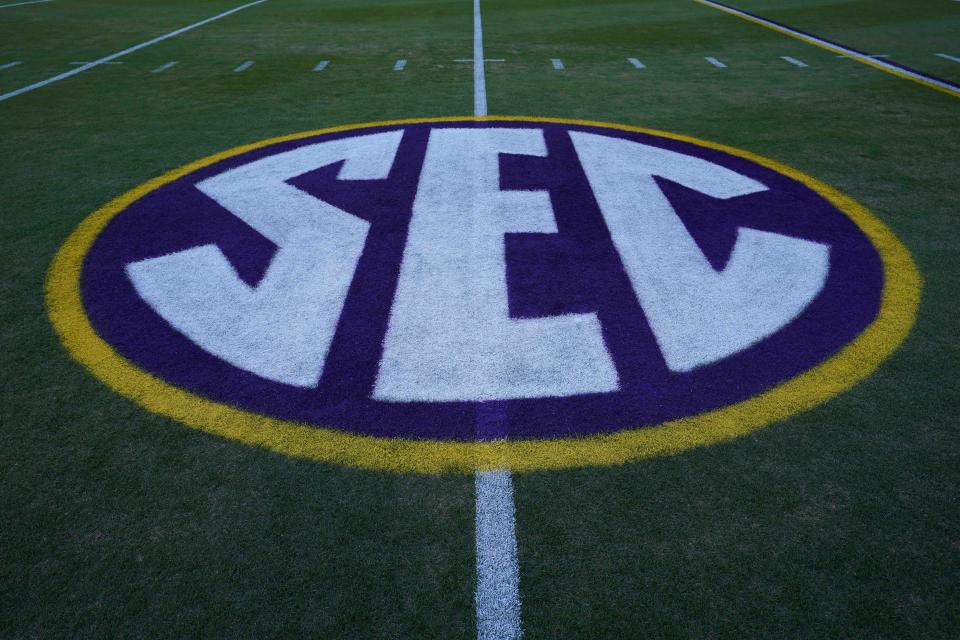Bohls: Football, television swallowing up college athletics in strange, new world order

If you’re taken aback by the recent conference realignment in the last week, you shouldn't be.
This isn’t realignment at all. It is upheaval and utter chaos and a new world order for college athletics, and it's been in full swing for a decade.
Let’s not sugarcoat it.
College sports will never be the same.
That doesn’t mean it will be better or worse — it could be either and both — but it will be decidedly different. And who’s to blame?
We are. Because America put college sports on a pedestal, made it its new idol and will worship it to no end. And that’s why television took over the sport, shaped it, molded it and produced it so that this is the inevitable end result.
In the span of just a few days, an entire Power Five conference crumbled. The Pac-12 became the Pac-it-in 4. And maybe no more.
The Big Ten became the biggest ten. Or 18. Or whatever it is next week if Florida State can find some ACC loopholes to get out of its grant of rights deal that has it in a stranglehold. Of course, if FSU’s lawyers can trump ACC lawyers, the Seminoles (and Clemson and possibly Duke and North Carolina) could be in the SEC or Big Ten the following day.
More: Bohls: Jerritt Elliott's Texas volleyball program rises above all the rest
And who’s to say any of this is ultimately binding? It’s a great time to be a media lawyer.
We may be seeing the advent of three mega-conferences: the SEC, the Big Ten and an ACC-Big 12 merger.
Why should we even think this will settle down into some degree of normalcy? Normalcy is so yesterday. What makes us think this couldn’t all happen again in 10 years? Heck, five. Maybe two. Tomorrow? Every school better keep its receipts.
Do all these teams in their new conferences sign new, binding (wink, wink) grant of rights deals? Or is everybody on a one-year contract? Guess FSU will teach us, but for now grant of rights is THE sticking point.
We all know it’s about greed and arrogance and what’s in it for me.
As former Big 12 commissioner Bob Bowlsby told me Wednesday, “I don’t know what the genesis of it is. I guess it’s (a message) that more money is better than less money.”
More: Golden: I will miss my Sports Mom, but what a beautiful life she led
Stripping the college game of its soul
One thing’s for sure. There is no longer a shred of collegiality in college sports. That’s for sissies. So yesterday. Hey, you can forget handshake deals or one’s word is his bond.
Goodbye to loyalty. So long to rivalries. Hello to NFL Lite.
This is the beginning of the revamping of college athletics as we know it. The days might be numbered for the little guys and quite possibly non-revenue and Olympic sports and old-school tradition.
“I don’t think it’s a positive trend that more and more resources are centered in fewer and fewer institutions,” said Bowlsby, who served three of the five Power Five conferences as athletic director or commissioner. “It’ll be harder on the overall enterprise. The athletic ecosystem is not better with the Pac-12 not in it. The SEC doesn’t need Texas and Oklahoma. But those decisions were made by businesspeople directed by TV partners.”
Who wins out of all this? And who loses?
The winners and losers are as obvious as the nose of George Kliavkoff’s face that kept growing as he blustered and blustered for months about how everything was fine, and the Pac-12 would sort things out in due time. Oh, were they ever sorted out.
Everyone has blamed Larry Scott, Kliavkoff’s predecessor, but a little more than 10 years ago, Scott came within an eyelash of pulling off the biggest heist of them all. He went to bed in Austin thinking Texas, Oklahoma, Texas Tech and either Texas A&M or Baylor were headed to the Pac-12 like Colorado.
Then, Texas changed its mind.
It did so because it finally got a clue and realized it was the worst move possible for fans in terms of travel, expense and late-night kickoffs and tipoffs and for athletes whose boarding passes would be as constant as helmets and shoulder pads and might never set foot in a classroom ever again. And that Monday morning, even as ESPN talking heads said the Big 12 was officially done, Texas told Scott no.

It was only later that Texas athletic director DeLoss Dodds, the ultimate mover and shaker, confided to me that if the Longhorns had left, they would have gone to the ACC and its student-friendlier time zone.
But all that did was delay the inevitable. Who cares about time zones these days? The more the better, right?
More: Texas' Ethan Burke seems to have edge in battle for starting spot on Horns' defensive line
How did we get here?
Kliavkoff was selling his conference’s media rights for a song. To Apple? A streaming network. While the cable industry — once the cash cow of college sports — has shrunk drastically from 110 million households to 65, who knows who the new broadcast players are. Move over, ESPN, for Apple and Netflix and Amazon Prime.
Reports said the Pac-12 might be able to reap a payday of $23 million per school although Arizona's president put the most accurate spin on that development when Bobby Robbins said it was like “selling candy bars for Little League.” Not exactly a compelling vision. What’s next? Go door to door from Phoenix to Portland begging for handouts.
Meanwhile, Oregon and Washington sold out for thirty pieces of silver. But that was better than no silver. And neither will get a full share of Big Ten revenue until 2030. But in taking $30 million a year instead of Apple peanuts — based on subscribers added, no less — did they really do anything so sordid that any of their colleagues didn’t already do?
Missouri started this mess when it put its hand up and told the Big Ten, “Pick me, pick me.” Colorado trumped Baylor and took a Pac-12 invitation when the getting was good. How’d that work out?
Or you can go back to 1990 when Arkansas took the SEC up on its offer.
Texas A&M said enough’s enough to big brother and bid Texas and the Big 12 adieu to head for the greener pastures of the SEC. Nebraska did the same, ticked off at Texas for the Longhorn Network, the Texas-led abolition of Prop 48 academic risks and Mack Brown for beating its Huskers at nearly every turn. You might suggest Texas killed Nebraska football, and you wouldn’t be wrong.
Say what you will, but Texas and Oklahoma showed more loyalty than most. They stuck around and tried to make the Big 12 work longer than four of the other 11 schools. Where was their loyalty?
More: Texas football enters 2023 season ranked No. 12 in coaches poll
College football will never be the same
It’s sad and some might say tragic that it’s gone this way, but it could end no other way when we saw teams uproot themselves from friends and neighbors and barely leave a goodbye note on the pillow.
It sounds weird to blame the fans for creating this situation because they put college football — and to a much lesser degree, March Madness — on a pedestal. But we want what we want. And we want it now. Call it drive-through college athletics. Immediate gratification.
The fans have pleaded with ESPN and CBS and Fox and NBA for more. But not just more football. More Alabama-Georgia. More Oregon-USC. More Ohio State-Michigan. More Texas-Oklahoma.

Name brands versus name brands. Big-boy football. The casual fans are going to love it every week. But those true diehards who are wondering how to pay for a USC game at Penn State, not so much. How many cross-country trips can they afford? Remember, they’ve also got to save some money for the ever-expanding playoffs in December and January. February, anyone?
We can’t be bothered with the lightweights of the sport anymore. There is no room in the inn for the likes of pick-any-team with a budget below $100 million. Our insatiable appetite for only the best of the best must be quenched.
As SEC Commissioner Greg Sankey put it this week on Paul Finebaum’s show, “We have this contiguous group. We don’t need to be in four time zones to generate interest on the West Coast.”
Amen.
The SEC doesn’t need a team within 1,000 miles of the West Coast to attract viewers who live there.
Did Rutgers suddenly get credit for bringing more East Coast eyeballs to the Big Ten? I think not.
More: Texas tight end Ja'Tavion Sanders is 'ready to show the world what I'm really capable of'
So ESPN can throw millions or billions around at the same time it has three rounds of layoffs of good and talented people. What does that say?
The scrap heap is growing by the day.
I’m sorry, Oregon State and Washington State.
And what of the student-athletes? Where do their best interests lie? When we're dealing with more mental health issues than ever before, how are these athletes supposed to deal with long trips and big-time games and the stress of living up to NIL deals.
And are they even going to be in the classroom? Or take all their classes on Zoom? Are their grades going to suffer? Is their quality of education? Does academics even matter anymore? What’s in it for them?
Should be a field day for tutors. And psychiatrists.
When, and how, will this all end?
There are so many ways this could go.
We are clearly in the era of the mega conferences, and it’s not unlikely that we wind up seeing three 24-team conferences with the rest fighting for television scraps. Congrats, Big 12. After picking up Utah, Arizona and Arizona State, you’re once again a player.
That is very troubling and egregiously unfair to schools like Oregon State and Washington State, two of the obvious have-nots in this new age. But there are as many have-nots as haves. Lots of people have been hurt.
The bigger football grows, “the more in jeopardy will be non-revenue sports and male Olympic sports,” Bowlsby said. “And women’s sports will get smaller. Football may think it ought to keep all the money.”
Maybe the NCAA will crumble as well and give way to a Super NCAA with as few as 70 schools competing.
Or perhaps football will break off on its own, negotiate its own television contract, or maybe even the SEC, Big Ten and Big 12 will buy ESPN from Disney or create their own network.
And all the rest?
They can always sell candy bars.
This article originally appeared on Austin American-Statesman: Football, television drive up revenue, drive out have-nots

